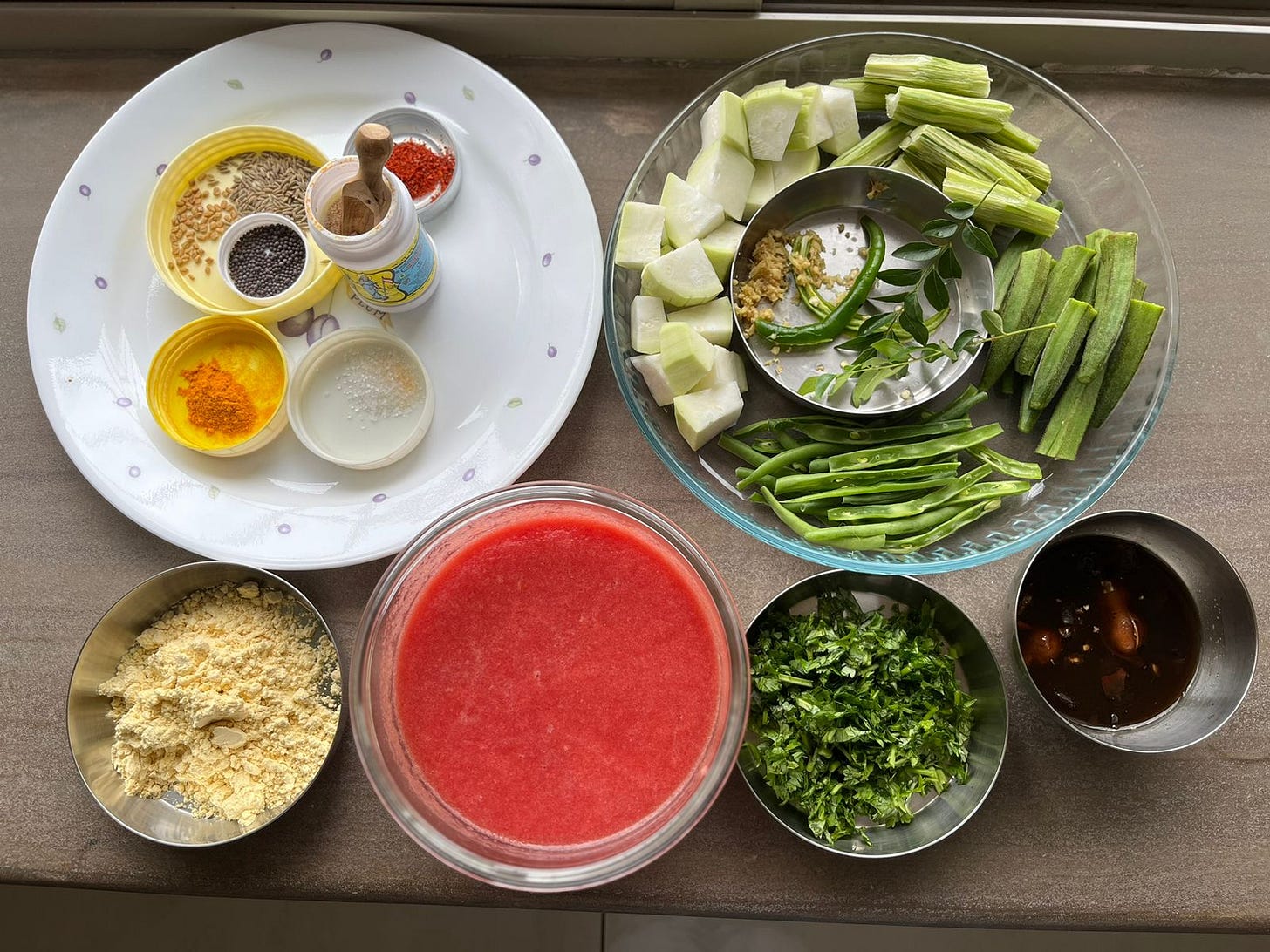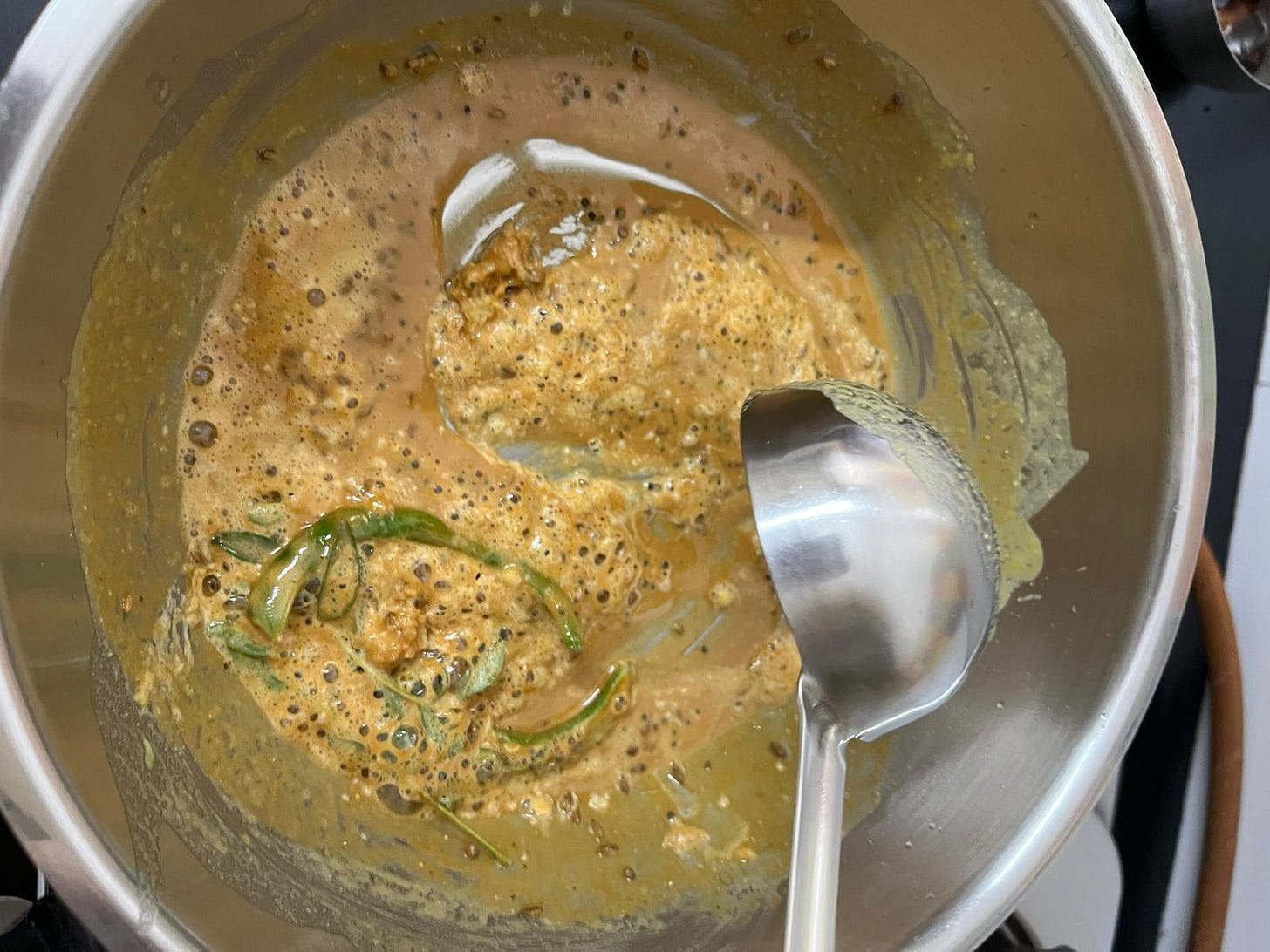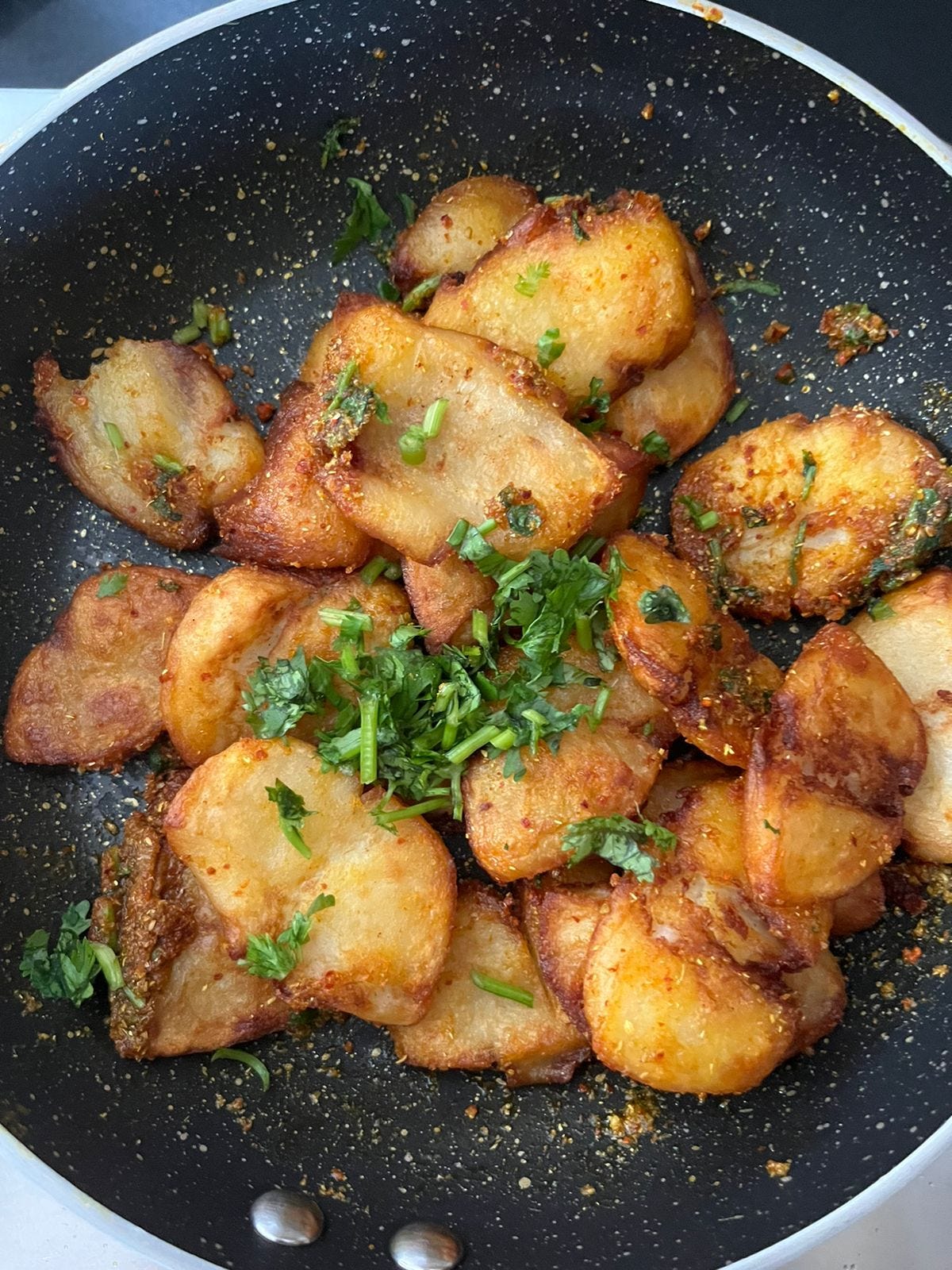If I can smell caramelised chickpea flour wafting in from the kitchen, then I know where I am
I dive deeper into the origins of the traditional Sindhi curry which may be at odds with my family recipe but has nonetheless helped me get one step closer to understanding my ancestry.
Growing up, I always knew that Sunday had arrived by taking in the scent of the traditional Sindhi curry (also called Sindhi kadhi) because it was a treat worthy of Sundays that allowed ample time for carb-induced naps. If I had to craft a calendar based on the meals my family and I ate in any given week, I can guarantee you that we would instinctively associate Sunday with Sindhi curry and Monday with a lean gourd vegetable side dish to balance our carb fest from the previous day with some antioxidant and flavonoids action. The key ingredient in Sindhi curries is the chickpea flour base which makes it unique to other South Asian curries, including the renowned yogurt curry (dahi ka kadhi) which consists of yogurt and chickpea flour. The scent of the caramelised chickpea flour and steamed basmati rice wafting through the kitchen always reminded where I am, and that food was on its way. When I think of what I associate the most with as part of my Sindhi identity, then it is the smell of caramelised chickpea flour on a Sunday morning.

Despite the chickpea flour being the star of the show, my family recipe calls for a generous puree of tomatoes that adds some citrus to this heavy chickpea flour base, making the curry complete. At some point, the tomatoes became such a central feature in our recipe that we even began calling it tomato curry within our household and still do to this day. It was only when I interacted with non-Sindhis that I found out that our method of using 95% tomato puree and 5% chickpea flour was a spin-off of the original which is entirely comprised of chickpea flour. If continuing with preparing the traditional Sindhi curry is a badge of honour for a culture without roots, a passport almost that I thought verified my Sindhi heritage, then how Sindhi is my family’s tomato curry?
The silky, smooth Sindhi curry is a reddish-brown concoction that has a nutty chickpea taste combined with the tartness of either tomatoes or tamarind or Goa butter tree (called kokum in Hindi), a plant that complements the richness of the curry with a zing of tartness. The Sindhi curry would be incomplete without the addition of horizontally slit okra slices and in certain variations, even potatoes and moringa drumstricks (not the KFC kind) and accompaniments include steamed rice and double-fried potatoes called tuk aloo. Why only have one carb when you can have two, right? In certain households, that of my grandfather’s, the curry is also accompanied by tiny balls of deep-fried chickpea flour that are then run through sugar syrup called boondi. The boondi is meant to cut through the savoury taste of the curry with a burst of sticky, sweet goodness. Evidently, chickpea flour is at the very heart and soul of a meal involving Sindhi curry.

It is tricky to understand the role that chickpea flour plays in a traditional Sindhi curry without really knowing exactly how it is cooked. The traditional recipe calls for multiple and generous ladles, not mere tablespoons, of chickpea flour to be tempered in clarified butter or ghee along with mustard seeds, cumin and fenugreek seeds and the tempering is where the magic happens. The chickpea flour begins to change colour, like a sky that is darkening slowly, from pale yellow to bright fawn and then ultimately to golden brown. Knowing how far the chickpea flour must be caramelised is as much a thing of sight as it is of smell. How light is light brown? Is it the lighter end or darker end? The skill of knowing when to take the tempered chickpea flour base off the stove only comes with experience and unfortunately, mine has always resulted in stomach pain.

Chickpea flour is having a moment in Western media for being a protein-rich ingredient but one of the discourses that I’m yet to see more discussion around is the dangers of undercooking chickpea flour. My first-time making Sindhi curry resulted in me rushing home from a lovely Sunday out shopping and lying in bed in foetal position and losing my appetite altogether. Turns out that chickpea flour would become my personal Moby Dick anytime I attempted this curry thereafter – an elusive tan leather beast that I was yet to tame in my wok.
The second discourse that is disregarded in favour of nature’s protein powder is how heavy chickpea flour can be on our digestive system. According to researchers, chickpea flour maintains the structure of its dietary fibre and therefore creates a form of resistant starch that takes more time to break down in our stomachs than say wheat flour would. This explains why every Sunday meal was followed by my father insisting that the three of us go out for a walk to aid our stomach’s digestion process. My memories of chickpea flour as an adult became tainted with experiences of not being able to enjoy a childhood indulgence, taking it far away from memories of excitement of eagerly drooling over the same meal. If chickpea flour was interwoven with my understanding of my Sindhi identity, then what would it be reduced to when my body could no longer properly digest it?
This pivot made me want to dive deeper into why chickpea flour became the crowning glory of Sindhi curries everywhere. While I have not been able to find many documented records of the recipe’s origin, I have done the next best thing – I WhatsApped my grandfather, the fountain of all desi food knowledge. In my previous post, I mentioned the fact that Afghani trade brought dried fruits and nuts to pre-partition Sindh. It turns out that Sindh was also on the trading route of traders from Central Asia or the Middle East, as per the stories my grandfather heard from his parents. Chickpeas may be quintessential to Indian and South Asian cuisine in general, but they were brought to the subcontinent from Turkey. It’s hard to pinpoint the exact year that chickpeas made their way to the subcontinent but sources cites that the desi cultivar – one of the most common cultivars grown in India today – was found in Turkey 11,000 years ago. Additionally, the second most common chickpea variety, kabuli channa, made its way to India through Afghanistan. It is fair to assume that chickpeas were widely available in pre-partition Sindh to the extent that they were ground into a fine powder to be used in curries and other side dishes as well. That still leaves the question of why chickpea flour was chosen to become the focus of Sindhi curry.
My grandfather purports that the topography of Sindh didn’t allow for growing a variety of fresh vegetables given the arid, mountainous region that our ancestral villages were based in. The mountains and the Indus River brought their fair share of harsh winters making heat-inducing, protein-packed foods a necessity for survival. Chickpeas just so turned out to be a crop that grows remarkably well even in -8 or -12°C temperatures. Furthermore, there is no possibility of coconut trees ever flourishing in such a dry, cold and high-altitude region making coconut milk, a typical ingredient in South Indian curries, missing in action altogether. When life gave Sindhis chickpeas, they made Sindhi curry out of it because what else was there to make? Thus, the Sindhi curry was born out of necessity of the vegetation but also to have a curry that is worthy of family celebrations to be served to guests with deep-fried sweet chickpea flour balls and double-fried potatoes.
I could very likely be mistaken in my assumptions, but some detective work does more to help fill the gaps than altogether not asking these questions. I have been keeping up with Indian food writer Rushina Munshaw Ghildiyal on Instagram who leads culinary chronicling workshops online and that has made me think deeper about the term culinary chronicling and how important it is to have something more than a verbal record of culinary traditions and recipes. As a child, I accepted that Sindhi curry is Sindhi curry with the same ease of accepting that the sun will surely rise the next morning. As an adult with some level of intolerance towards the ingredient that makes Sindhi curry Sindhi, I can be reassured by the fact that I have put together a few puzzle pieces about this curry despite not cooking it in the traditional manner.
I also strongly believe that what makes cuisines so special to any inter-generational family is seeing its evolution through different generations. They are living, breathing entities that are always on the move, taking into account migration, trade, colonisation and what’s most readily available. If my progeny continue to make tomato curry while knowing that their ancestors made something delicious and beautiful out of nothing much, then that’s more than enough at the end of the day.
Recipe for Sindhi curry with steamed rice and tuk aloo (For 4 people)
Ingredients:
For Sindhi curry
Puree of 6 medium tomatoes
10g of okra - horizontally slit
10g of cluster beans or french beans - horizontally slit
10g of moringa drumsticks - washed and peeled (optional)
A handful of curry leaves
A quarter of an inch ginger - grated
1 green chilli - horizontally slit
5 tablespoons of chickpea flour
1 tsp of turmeric
1 tsp of chilli powder
A pinch of asofoetida
1 tsp of cumin
1 tsp of mustard seeds
1 tsp of fenugreek seeds
1 cup of tamarind pulp
6 tbsp of ghee or oil of your choice
1 cup of water
Salt to taste
Chopped coriander
For tuk aloo
6 medium potatoes cut horizontally
1 tsp of turmeric
2 tsp of chilli powder
2 tsp of coriander powder
2 tsp of dried raw mango or amchur powder
Salt to taste
Oil for frying
For steamed rice
400g of rice - washed and soaked for over 15 minutes
Recipe:
Take a medium-sized pot and put it on high heat. Once the pot gets hot then add the 6 tbsp of ghee and as soon it all mets away, add the mustard seeds. Upon hearing the crackling of the mustard seeds, add cumin and fenugreek seeds.
As the flavour of the cumin and fenugreek begins to infuse with the mustard seeds, add the chickpea flour and keep stirring it on a low heat. Keep a hawk eye on the chickpea flour as it changes colour and once it gets to a silky smooth golden brown, add the curry leaves, chillies and ginger to the pot. Refer to the third image in this post to get the colour exactly right.
immediately after that, take it off the stove for a moment and add the chilli powder and turmeric so the chickpea flour and chillies do not get brunt. Add the tomato puree and place the pot back on the stove on medium heat.
Add the okra, cluster or french beans and the moringa drumsticks if you have them. Place a lid on the pot and let the curry simmer for 15 minutes.
In the meantime, add some oil to a shallow pan and once it gets hot, add the cut potatoes one by one. Fry them until they are crispy and golden brown. Take them out of the shallow pan and onto a plate with paper towels to soak up the oil and let it cool down.
Cook the rice in a pressure cooker, open pan or instant pot with double the amount of water (800l) and a teaspoon of ghee.
The fried potatoes will have cooled down by now. Take one fried potato in the palm of your hand and gently squeeze it and put it back down on the plate. Repeat this process for all the pieces of fried potato.
Heat the shallow pan for frying again and add the smashed potatoes to it one by one. Once the potatoes look brown on the edges, take them out and place them on a plate with a fresh kitchen paper towel. In a bowl, prepare the dry spices mix and toss the potatoes in the spices mix. Add chopped coriander.
The curry will have deepened in colour at this point and the best way to be sure that it is cooked is to taste the french or cluster beans. If they are soft, then the curry is ready. The okra takes lesser time to cook as do the moringa drumsticks which is why the french or cluster beans are a good barometer for checking the progress of the curry.
Add chopped coriander to the curry and pour it into a bowl and devour it with steamed rice and tuk aloo. If you like poppadoms, then fry them for an extra crunch element (a Sindhi feast is incomplete without poppadoms).





Beautifully written Harshita! Chickpea flour is so prolifically used on both sides of the Thar... be it pakoras, gujarati kadhi, fafda and all manner of garsan, Rajasthani gatta which has its Sindhi twin in darrey ji kadhi... the list is long. Savoury or sweet it finds a spot for every occasion!
Fantastic writing and I loved the history behind it all that you covered really well. I love that your grandfather could have a chat with you, that’s so precious! Wish I could do the same